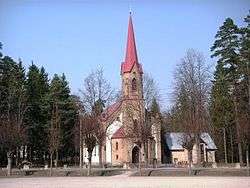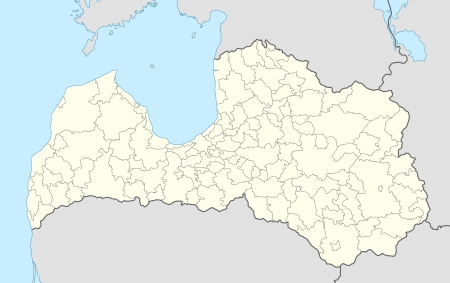Ogre, Latvia
| Ogre | |||
|---|---|---|---|
| Town | |||
 | |||
| |||
 Ogre Location in Latvia | |||
| Coordinates: 56°49′07″N 24°36′20″E / 56.81861°N 24.60556°ECoordinates: 56°49′07″N 24°36′20″E / 56.81861°N 24.60556°E | |||
| Country |
| ||
| District | Ogre District | ||
| Town rights | 1928 | ||
| Government | |||
| • Mayor | Egīls Helmanis | ||
| Area | |||
| • Total | 13.58 km2 (5.24 sq mi) | ||
| Population | |||
| • Total | 26,760 | ||
| • Density | 1,970/km2 (5,100/sq mi) | ||
| Time zone | UTC+2 (EET) | ||
| • Summer (DST) | UTC+3 (EEST) | ||
| Postal code | LV-500(1-3) | ||
| Calling code | +371 650 | ||
| Number of city council members | 13 | ||
Ogre (![]()
Ogre is composed of three parts: Jaunogre (meaning "New Ogre"), Ogre (the center of the town), and Pārogre (meaning "Ogre across [the river]" though not all of the named region is across the river).
The name of the town comes from the Ogre river. The Ogre village was first mentioned in 1206, called "Oger" in German. In 1861, when a railway Riga–Daugavpils was built, Riga's residents started to build summer cottages here. In 1862 Ogre became a health resort.
The town's coat of arms was granted in 1938 and shows the beautiful river and pinewoods of Ogre. There is a cultural centre, an art school and a music school in Ogre. It has three Latvian language schools, and one Russian language school - Jaunogres vidusskola.
The town also has a cemetery with the remains of German soldiers who died during the First and Second World Wars, or died in captivity between 1944 and 1951.
Ogre is the hometown for most recent (2016/17) Latvian ice hockey champions HK Kurbads.
Etymology
There are two main versions of the etymology of Ogre's name. The first states that the name of the river from which this town derives its name is of Russian origin (угри [ugri], meaning "eels") because there used to be many eels in the river Ogre. Whereas Estonian linguist Paul Alvre takes into consideration an older form of the Ogre river's name (Wogene, Woga) first found in Livonian Chronicle of Henry (1180—1227), and argues that it cognates with Estonian word voog (with possible meanings: "stream, flow, waves"), therefore showing connection with Finno-Ugric languages, most probably early Livonian language. A popular folk legend says that Catherine the Great of Russia was the one who gave the river this name because there were a lot of eels in the river;[1] however, this lacks any evidence.
Places of interest
The building of Ogre railway station
Architect: A. Siņicins
This was built in 1859. In 1944 the building was blown up. It was restored in 1947 following the Soviet standard project of railway stations.
The Pārogre railway station
It was opened on 1939 thanks to the donated building materials. This building is a unique example of wooden railway stations. It is one of few wooden stations along the railway line Riga - Daugavpils that has still remained unmodernized.
The Ogre Museum of History and Art
Address: Kalna prospekts 3, T. 5024345
Structural engineer: T. Hermanovskis
This building initially was designed as the detached house and built in the style of Constructivism in 1927. There is an exposition in the museum displaying the history and the development of Ogre Town and Ogre District. Regular exhibitions, both art and thematic ones, are organized in the exhibition hall.
The Museum of Latvian Scouts and Guides
Address: Mālkalnes prospekts 10, T. 5046145
This is the only one in the Baltic States. In the museum you can find information about Scouting.
St. Meinhard's Roman Catholic church
Address: Meža prospekts 1, T. 5022458
Architect: L. Šmits
The church was built in 1997. The altar, built in 1901, was donated by St. Mary Magdalene's church in Riga.
The Ogre Lutheran church
Address: Brīvības iela 51, T. 5047915
Architect: H. Kundziņš
The church was built in 1930 in the Neo-Gothic style.
St. Nicolas Brīnumdarītāja (Miracle-worker) Orthodox church
Address: Krasta iela 15
Architect: L. Kļešņina
The house "Kūrmāja"
Address: Brīvības iela 32
Architect: V. Šervinskis
This was built in 1926 as a cafe and a boarding house with specially made palm tree garden. In 1928 the editorial office of the first town's newspaper, Ogres Straume, was located in this building. The first competition of "Miss Ogre" took place there. The high circles of society used to gather in this place for various social events.
Brīvības Street 12
The house was built in 1901 as a living house and a shopping centre. Then there was the Militia of Ogre District for 40 years. After the restoration (1997–1998) there was the recreation centre "The Police Academy '98".
Brīvības Street 11
Architect: E. Smurģis
This was built in 1925. It was the first hotel and the restaurant in Ogre, "Esplanāde". Now the building houses the Ogre Art School and the Ogre branch bank of Hansabanka.
The monument to the victims of Communist regime
This was unveiled in 1989, and is situated on the crossing of Upes and Meža Prospekt.
The Lazdukalni dendrology park
Address: Pavasara gatve 6, T. 5067503
One can see here more than 7 000 plants, 412 different trees and decorative shrubs. To reach the top of the hill and enjoy the beauty of water lilies, a visitor must climb 100 steps up the hill. One can take a walk along the Purva Taka (Marsh Path). The area of the park is 8,5 h.
An open-air stage
It was built in the 1960s and various regional and national events take place there.
The bridge across the River Ogre
The authors: V. Salcēvičs, J. Mēness, T. Vitkuss
This was built in the late 1960s. It is the only arched bridge in Latvia (94 m long and 4.5 m wide).
Krasta Street 11
Architect: E. Laube
The house was built in 1924 as a summer cottage. During the period of 1920–1930 there was a sanatorium, but after Second World War the house was formed into the Pioneer's Club. Now there is the Ogre District Prosecutor's Office.
Zilokalnu Prospekts 17
The house was built in 1927 and owned by V. Šervinskis, the architect, who designed a lot of summer cottages in Ogre.
BOVU rehabilitation centre "Ogre"
Address: Gaismas prospekts 2/6, T. 5022141
Architect: K. Pekšēns
It was built in 1927. The building joins two architectural styles - Functionalism and National Romanticism. The author of the wall paintings fresco secco have remained untouched. They were restored during 1988–1990.
The memorial signpost in honour of folk song collectors
It was unveiled in October 1993 near the homestead "Vecuteles" by the poet I. Ziedonis.
The memorial sign to Latvian theatre and Auseklis
This sculpture with the words "Theatre, Auseklis, Vecuteles 1873" on it was made by P. Meļļa and was unveiled on 18 September 1990.
The oak tree planted by the Russian Empress Catherine I
It can be found near "Truču" homestead. It stands in honour of a girl, born in an indentured family who later ran away and was adopted by the clergyman Ernst Gluck and became the ruler of Russia. During the time of her ruling, some soldiers came to Ogre neighbourhood and asked for the river full of eels (Russian - "угрь"). The river probably got its name "Ogre" when making this Russian word ("угрь") sound more Latvian, and later the same name was also given to the town.
Sports
Ice hockey, basketball and handball are the most popular sports in Ogre.
Ice hockey club Essamika won the only Latvian Hockey Higher League championship title up to this day. In the later years Ogre has got 8 silver medals: 5 with ASK/Ogre and 3 with HK Kurbads.
Ogre has a Latvian Basketball League and Baltic Basketball League team, BK Ogre/Kumho Tyre, which entered the Latvian highest league after winning the gold in Latvian second league.
Ogre's handball team HK Ogre/Miandum has won multiple medals in the Latvian Handball Higher League and won the silver medal at the 2013–14 season as the highest achievement.
FK Ogre, the city's main association football club, plays in the Latvian First League.
International relations
Twin towns — sister cities
References
- Alvre, Paul Eesti ja liivi keeleaines Henriku Liivimaa kroonikas (III) (Keel ja Kirjandus, 1985)
Notes
- ↑ "Ogre - pilsēta uz sliedēm". Diena. Retrieved 28 July 2014.
External links
| Wikimedia Commons has media related to Ogre, Latvia. |
- Official website in English, Latvian and other languages

